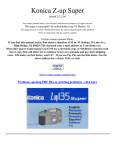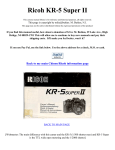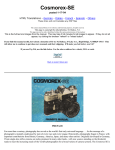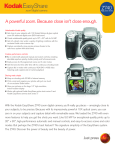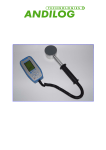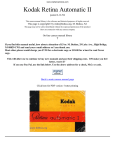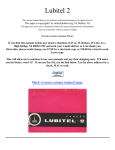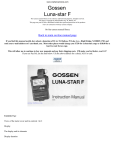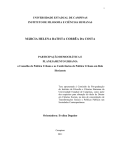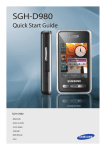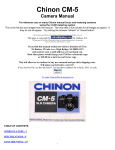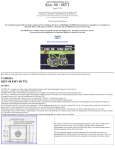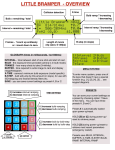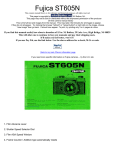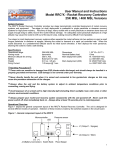Download Karat 36 user manual
Transcript
Karat 36 posted 4-26-'03 This camera manual library is for reference and historical purposes, all rights reserved. This page is copyright© by [email protected] M. Butkus, NJ. This page may not be sold or distributed without the expressed permission of the producer I have no connection with any camera company On-line camera manual library This is the full text and images from the manual. This may take 3 full minutes for all images to appear. If you find this manual useful, how about a donation of $3 to: M. Butkus, 29 Lake Ave., High Bridge, NJ 08829-1701 and send your e-mail address so I can thank you. Most other places would charge you $7.50 for a electronic copy or $18.00 for a hard to read Xerox copy. This will allow me to continue to buy new manuals and pay their shipping costs. It'll make you feel better, won't it? If you use Pay Pal, use the link below. Use the above address for a check, M.O. or cash. Back to main camera manual page TO ALL FRIENDS OF THE KARAT, Thus we may be permitted to address you, for if you are reading this booklet, you are sure to have joined the happy circle of lucky people who own a Karat 36. We should like first of all to congratulate you on the wise choice you have made of a perfect miniature camera. Your selection, we are certain, was determined not only by the camera's attractive appearance, but also by its quality and efficiency, and not least by the confidence justified by every product of the Agfa Camera Works. The vast experience of our factory has gone to produce in the Karat 36 a miniature camera of a perfect type which will satisfy all requirements. Thanks to its collapsible rapid-feeding lever that sets the shutter and ensures speed in setting and releasing it again, the Karat 36 has become the ideal camera for all amateur and professional photographers and for all. press work. 4.butkus.org The idea behind the construction of this camera was to produce an absolutely fool-proof camera, simple in its mechanism and easy to handle. But never forget that you have in your hands a first-class optical instrument of precision construction and that careful treatment is no more than its due. We would, therefore, request you to read these directions carefully. They have been kept as helpful and short as possible. Practice the operations in the illustrated part, first without a film in the camera. You will then be able to manipulate your camera quickly and steadily in all circumstances. Get accustomed to switch the rapid-feeding lever with an even, firm jerk. This will enable you to achieve maximum speed in making exposures. Practice focusing too. After a short time you will find that you have no difficulty in focusing even tiny objects quickly and satisfactorily. Never use force! Protect your camera from dust and never expose it too long or unnecessarily to sunlight. Avoid touching the lenses with your hands, to clean the outer surface of the front lens and the window of the view-finder, use only a clean, soft linen rag. Strictly speaking, all this advice goes without saying But keep it in mind and this excellent miniature camera will give you constant delight. You will be amply repaid by your results, whether in the fascinating field of black and white art or in the wonderland of color photography. www.orphancameras.com A close study of the illustrated pages following these hints will make you familiar with the mechanism and show you how to handle the camera. You will find other details worth knowing in the second part of the booklet. AGFA CAMERA WERK, MUNCHEN To open the camera, move locking slide outwards and swing the camera back open. Firm pressure on the camera back will help to release the locking slide. 4.butkus.org Raise the hinged film guide. Turn the milled disc of the winding-spool, until the slit for inserting the film, on which the carrying tooth is visible, is on top. Pull out re-winding knob of counter spool as tar as it will go and press it back again, after having inserted a miniature film cartridge, turning the knob slightly till the cartridge spool is engaged. The Karat 36 is fed with the standard miniature film cartridge, It will not take the special 12-exposure "Karat Cartridge" of the Karat 12 model. Insert flap of film in slit of spool up to second film perforation with which the carrying tooth must engage correctly. Turn Close camera firmly, but without force. milled disc of spool until the film is tightly Before closing the camera make sure that stretched. The film must be pulled out of the hinged film guide is lowered. cartridge in its full width by about 1/2" and must lie within the edges of the film channel. Then lower hinged film guide, Turn film counter disc clockwise to "A" by pressing finger on small milled knob Press the brace-lock device which makes the lens board spring forward into position for taking pictures. At low temperature lens board may need a gentle pull. Important! It is only in this postion that the rapid-feeding lever can be operated. Set lever for lens aperture at the desired number of aperture scale. With thumb or forefinger turn rapidfeeding lever as tar as it will go. (Simultaneous film transport and shutter cocking). Don't obstruct knob of rewinding spool which turns with the lever. Double exposures as well as ,,blanks" are prevented by special blocking device. Press the release button down steadily and completely with the upper joint of the forefinger, putting the top of the finger firmly on the camera. Repeat above operation. The counting device now points to a mark before "1". 4.butkus.org For time exposures set shutter at ,,B". Pressure on the release button opens the shutter which closes Set exposure time by turning the milled when the button is set loose. To use a cable release, ring with exposure times engraved on it to unscrew flat cap on release button. For long-time the triangular mark. In order to save the exposures, lock depressed release button by means shutter, always set time of exposure before of lever "T". setting shutter. Important: Lever "T" must otherwise always be in horizontal position. In order to focus, bring range view finder close to eye and direct camera towards object. Take knob of focusing lever between tips of middle and ring finger of your left hand to operate lever. If the object lies beyond the distance set, its image appears in the viewfinder as divided horizontally into two halves that do not fit. Adjust by focusing lever until I the two halves fit to form an undivided image. This is a sign that the camera is at the right focal distance which can be verified by looking at the scale in feet on the valuation ring seen from above in the small window on the lens board. www.orphancameras.com When taking upright pictures, the little finger of the left hand holds back the lid of the Ever-ready case. There are three things to remember: Set rapid-feeding lever once more, the counter disc now shows the number 1 and a. aperture and exposure time must be set the first exposure can be made. Camera must be kept level. Hold it steady with both hands. Before making exposure check b. film must be moved forward which aperture and exposure time once more. automatically sets shutter, To close camera, push back brace-lock and press down lens board on both sides. c. lens must be focused and shutter. released. When the picture counting disc shows the number "36" the film has advanced for the last exposure. Keep locking-knob "R" on bottom of camera depressed and turn re-winding knob To re-wind film pull out milled re-winding in the direction of the arrow, until the film knob halfway, to facilitate manipulation. is wound up. This is indicated by the fact that re-winding knob can be turned, even if locking-knob is released. Take out film cartridge after re-winding Open back of camera by releasing locking- knob has been pulled out to its full length. slide. Firm pressure on the camera back will Close camera. Never forget to lower hinged help to release the locking slide. film-guide, as otherwise the camera will not close. Wrap up exposed film cartridge immediately in foil-lined paper or the like, so as to protect it from light, and mark it as exposed film. Secure camera in Ever-ready case by screw at bottom. FURTHER IMPORTANT HINTS AND TECHNICAL DATA Up till now, dear Karat friend, you have been listening to a lightning lecture on the mechanical handling of the Karat 36. In the following paragraphs we wish to give you additional important hints of a general kind which we urgently recommend to your occasional study. GENERAL REMARKS The right film is the customary 35 mm Standard Miniature Film Cartridge for black and white or color pictures, size 24 x 36 mm. The "Karat Cartridge" specially made for the Karat 12 camera cannot be used. Dented cartridges cause obstructions! So don't use cartridges in which the film is jammed so that it does not come out smoothly. It is advisable to insert the cartridge in diffused light. By operating the rapid-feeding lever, the film is moved at one jerk for the length of a picture, and at the same time the Compur shutter is set. Operate rapid-feeding lever only with opened camera (position for exposure)! Simultaneously with the operation of the rapid-feeding lever, the rewinding knob turns (this is the sure sign that the film is being fed properly). See, therefore, that this knob is not inadvertently impeded while film is being fed. A locking device prevents the annoyance of double exposure or unexposed film. OPTICAL EQUIPMENT The Karat 36 is made in three types, with the Xenon f/2.0, the Heligon f/2.0 and the Xenar f/2.8. Focal length for all types is 50 mm. It is scarcely necessary to say anything about the quality and efficiency of these lenses which are known and appreciated all over the world. They are special lenses for miniature cameras, minutely calculated constructions in which the most exacting demands on optical equipment - for instance in color photography - have been taken into consideration. The coating of the lenses consists of an inconceivably fine layer on the lens surface. On the one hand, this protects and enhances the great transmissive capacity of our lenses, as reflection losses which can never be entirely avoided are greatly reduced, on the other hand it eliminates the disturbing reflexes (flare spots and "ghosts") that are apt to appear on many pictures and on the most interesting ones in particular, namely in exposures against the light. It is, therefore, understandable that such exquisitely fine optical instruments should need most careful treatment. Avoid touching the lenses with the hand and immediately remove any dirt or finger marks which are by no means as harmless on such highly polished lenses as is commonly supposed. In cleaning, use only a suitable piece of chamois leather or soft linen which must be absolutely free from dirt, oil or dust. Wind the cleansing material round your finger or over a small, pointed wooden rod. Never use an instrument with a sharp edge or made of metal. It stands to reason that lenses with the anti-reflex coating require still greater care. Remember that the coating has only a thickness of about 1/1000 mm. This does not mean that the coating is particularly susceptible to injury, but it is just as easily damaged by wrong treatment as is the highly polished lens. 4.butkus.org Bear in mind that when temperature changes are abrupt clouded lenses will only become clear again when the whole camera has accommodated itself to the new temperature. www.orphancameras.com Never try to take the lens asunder. THE COMPUR-RAPID-SHUTTER The shutter of the Karat 36 allows exposures of 1, 1/2, l/5, 1/10, 1/25, l/50, 1/100, 1/250 and l/500 second. The numbers engraved on the shutter ring stand for fractions of seconds, for instance: 2 = 1/2 sec., 50 = 1/50 sec. etc. As a rule the speed of exposure desired should be set before cocking the shutter by means of the rapid-feeding lever. For the same reason, namely in order to save the exceedingly delicate mechanism of the shutter, the camera should always be stored with its shutter unset. Make it a habit to set the shutter only immediately before making an exposure. For time-exposures the camera should be set on a tripod or at least on a firm support. In such cases it is advisable to use a cable release which is screwed into the nipple of the shutter release after the flat cap has been removed. 4.butkus.org The lever "T" that serves to arrest the release button when making long-time exposures must always be swung back to its horizontal position after the exposure has been made. Before closing the camera, make sure this lever is in the correct position. Never try to close the camera when the lever is upright. LENS STOPS The aperture scale on the Xenon and Heligon types comprises the following apertures; 2 2.8 4 5.6 8 11 and 16; in the case of the Xenar the apertures can be set in the same gradation from 2.8 to 16. The lens stops serve as a control of speed and depth of field. Therefore remember: low aperture numbers, e.g. 2.8 = high speed, but small depth of field, high aperture numbers, e.g. 16 = less speed, but large depth of field. The aperture scale has been so graded that between one aperture number and the next higher one, the speed of the lens is reduced by half. 4.butkus.org DEPTH OF FIELD The short focus lenses employed in the Karat 36 have a particularly good depth of field Study of the depth of field problem cannot be too strongly recommended. Familiaiity with it will increase your self-reliance, extend your possibilities and enable you to enjoy to the full all the advantages of your camera. You know already that with a large lens aperture (low aperture number) the -depth of field is smaller than with a high aperture number. It is also important to know that for close-ups the depth of the focus zone is smaller in extent than for distant views. Set yourself some tasks with different zones of sharpness and distances and solve them with the aid of the depth-of-field-table You will soon master the law of depth of field and the right use of the table without being a mathematician. The depth-of-field-ring on top of the Karat 36 is another valuable help always available. It is easy to handle. The stationary inner disc has engraved on it the distance numbers from 3 feet to CD (infinity), the movable knurled outer ring shows the aperture numbers corresponding with the zones of sharpness. These zones are narrowest with low aperture numbers and widen progressively with the higher aperture numbers, according to the law that with a small aperture number, the zone of sharpness is narrow and widens with a higher aperture number. If, for instance, by turning the knurled outer ring, the aperture number 16 is set at number 4 (feet) of the inner disc, the zone corresponding to aperture indicates the respective zone of sharpness between the two limit marks, that is from about 3.5 to 5 feet. Now if you set the lens of the Karat 36 at aperture 16 and a distance of 4 feet you will obtain a picture in which everything lying within the range of 3.5 to 5 feet will be sharply defined. Conversely, by means of the depth-of-field-ring, the aperture number necessary to obtain a desired zone of sharpness can be ascertained. The two point focusing method is a most convenient way for sticking to two distinct zones of sharpness On the aperture scale between 8 and 11 a red point is visible, while on the distance scale the numbers 10 and 30 are marked in red. Now set the aperture lever at the red point and the distance scale-- according to whether the picture is to be a close-up or a distant view-- at the red number 10 or 30. You will then get the following zones of sharpness: distance set at 10 feet = from 7 ft. 4 1/2 in. to 15 ft. 6 1/2 in. distance set at 30 feet = from 14 ft. 5 in. to oo (infinity). For most snapshots two-point focusing will suffice. THE RANGE VIEW FINDER The range view finder of the Karat 36 is a combination of view finder and coupled range finder, providing accurate focusing from 3 feet to co (infinity). Its use is considerably facilitated by focus sing for broad-view pictures on the vertical lines of the object focused, while for upright pictures, it is preferable to keep to the horizontal lines. The sharp image seen in the view finder shows on a reduced scale the exact field covered by the camera. In close-ups however, there is a slight deviation, the so-called parallax, which can be easily adjusted after a little experience, and it practically only occurs as a disturbance in pictures taken within a range of 3 to 6 feet. It is compensated by slightly lowering the center of the image in the view finder which can be done by simply tilting the camera up in the direction of the view finder. When the camera is held in vertical position the same divergency appears as a lateral deviation which is adjusted likewise by slightly swinging the camera sideways in direction to the view finder. TAKING CARE OF THE CAMERA Regular care lengthens the life of your camera. It should at least be examined and freed from dust frequently. Before inserting the film, remember always to remove from the interior of the cartridge any cartridge-dust and film-splints that may have accumulated. MISCELLANEOUS The rectangular socket on top of the camera is for holding accessories. SHUTTER LOCKED INADVERTENTLY Should the-shutter have been released by an inadvertent touch on the release mechanism of the lens-board, the result is a complete stop or jam, i. e. neither the feeding lever nor the release can be operated To remedy this, set the focusing scale at 3 feet, so that the cocking mechanism on top of lens board becomes accessible and you can easily press it with your finger tip Thus the shutter is set again and can now be released by the body release in the normal way. ORDER NO. - KARAT 36 2017/30 Xenar 1:2.8 coated lens, F = 50 mm, Compur-Rapid shutter 2017/35 Xenon 1:2.0 coated lens, F = 50 mm, Compur-Rapid shutter 2017/37 Heligon 1:2.0 coated lens, F = 50 mm, Compur-Rapid shutter Flash Contact The Karat 36 is provided with a 1/8 - in. (3-mm.) nipple to which a flashbulb release cable may be attached. Automatic synchronizing ensures that the flash coincides with the exposure. As a great variety of flashbulbs is available on the world market, all of them having different delay- and flashing-periods, it is recommended, when using a flashbulb, to set the shutter for 1/25 second. www.orphancameras.com









